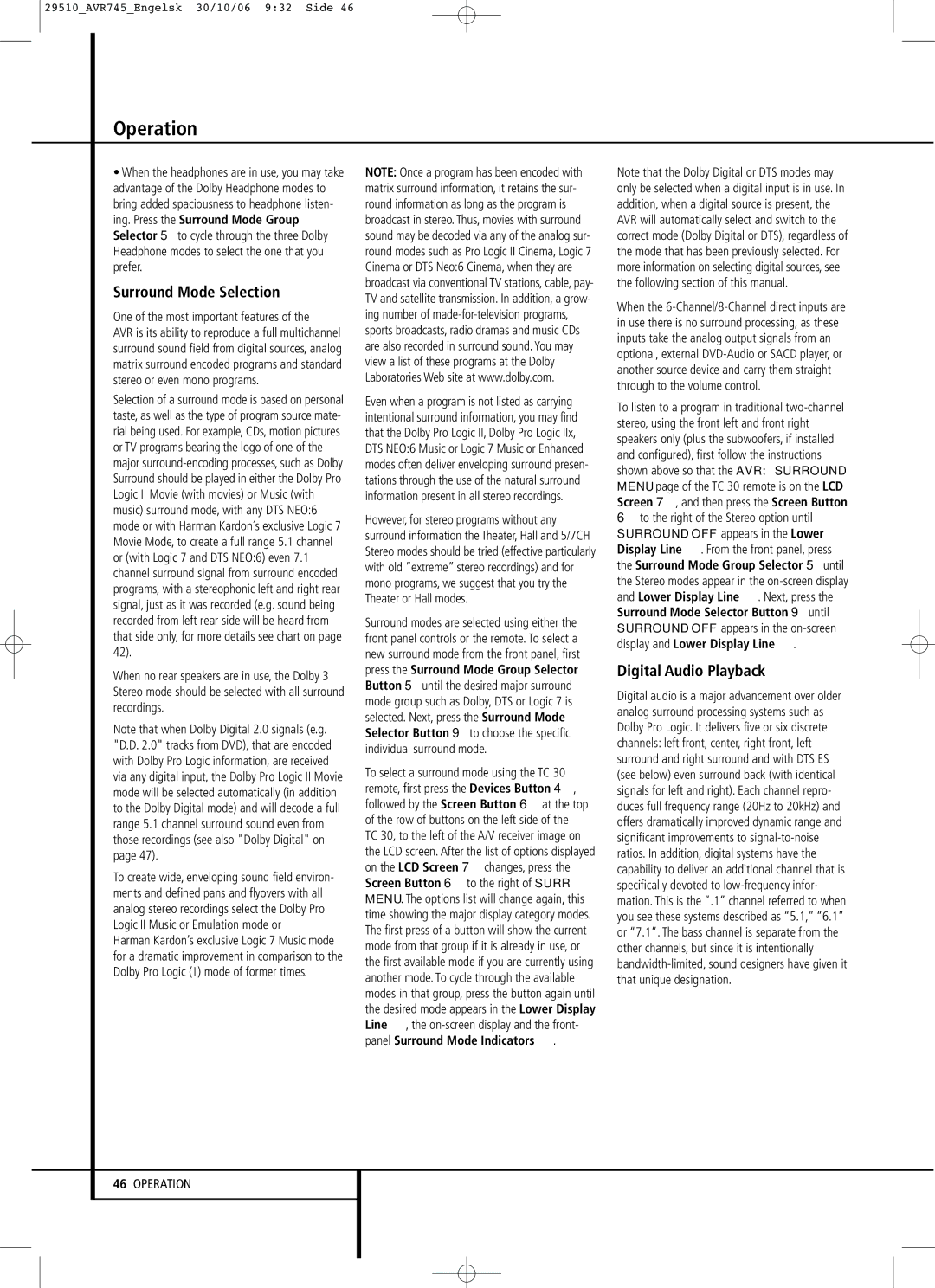
29510_AVR745_Engelsk 30/10/06 9:32 Side 46
Operation
•When the headphones are in use, you may take advantage of the Dolby Headphone modes to bring added spaciousness to headphone listen- ing. Press the Surround Mode Group Selector 5 to cycle through the three Dolby Headphone modes to select the one that you prefer.
Surround Mode Selection
One of the most important features of the
AVR is its ability to reproduce a full multichannel surround sound field from digital sources, analog matrix surround encoded programs and standard stereo or even mono programs.
NOTE: Once a program has been encoded with matrix surround information, it retains the sur- round information as long as the program is broadcast in stereo. Thus, movies with surround sound may be decoded via any of the analog sur- round modes such as Pro Logic II Cinema, Logic 7 Cinema or DTS Neo:6 Cinema, when they are broadcast via conventional TV stations, cable, pay- TV and satellite transmission. In addition, a grow- ing number of
Note that the Dolby Digital or DTS modes may only be selected when a digital input is in use. In addition, when a digital source is present, the AVR will automatically select and switch to the correct mode (Dolby Digital or DTS), regardless of the mode that has been previously selected. For more information on selecting digital sources, see the following section of this manual.
When the
Selection of a surround mode is based on personal taste, as well as the type of program source mate- rial being used. For example, CDs, motion pictures or TV programs bearing the logo of one of the major
When no rear speakers are in use, the Dolby 3 Stereo mode should be selected with all surround recordings.
Note that when Dolby Digital 2.0 signals (e.g. "D.D. 2.0" tracks from DVD), that are encoded with Dolby Pro Logic information, are received via any digital input, the Dolby Pro Logic II Movie mode will be selected automatically (in addition to the Dolby Digital mode) and will decode a full range 5.1 channel surround sound even from those recordings (see also "Dolby Digital" on page 47).
To create wide, enveloping sound field environ- ments and defined pans and flyovers with all analog stereo recordings select the Dolby Pro Logic II Music or Emulation mode or Harman Kardon’s exclusive Logic 7 Music mode
for a dramatic improvement in comparison to the Dolby Pro Logic (I) mode of former times.
Even when a program is not listed as carrying intentional surround information, you may find that the Dolby Pro Logic II, Dolby Pro Logic IIx, DTS NEO:6 Music or Logic 7 Music or Enhanced modes often deliver enveloping surround presen- tations through the use of the natural surround information present in all stereo recordings.
However, for stereo programs without any surround information the Theater, Hall and 5/7CH Stereo modes should be tried (effective particularly with old ”extreme” stereo recordings) and for mono programs, we suggest that you try the Theater or Hall modes.
Surround modes are selected using either the front panel controls or the remote. To select a new surround mode from the front panel, first press the Surround Mode Group Selector Button 5 until the desired major surround mode group such as Dolby, DTS or Logic 7 is selected. Next, press the Surround Mode Selector Button 9 to choose the specific individual surround mode.
To select a surround mode using the TC 30 remote, first press the Devices Button 4, followed by the Screen Button 6 at the top of the row of buttons on the left side of the TC 30, to the left of the A/V receiver image on the LCD screen. After the list of options displayed on the LCD Screen 7 changes, press the Screen Button 6 to the right of SURR MENU. The options list will change again, this time showing the major display category modes. The first press of a button will show the current mode from that group if it is already in use, or the first available mode if you are currently using another mode. To cycle through the available modes in that group, press the button again until the desired mode appears in the Lower Display Line ˜, the
To listen to a program in traditional
6to the right of the Stereo option until SURROUND OFF appears in the Lower Display Line ˜. From the front panel, press the Surround Mode Group Selector 5 until the Stereo modes appear in the
Digital Audio Playback
Digital audio is a major advancement over older analog surround processing systems such as Dolby Pro Logic. It delivers five or six discrete channels: left front, center, right front, left surround and right surround and with DTS ES (see below) even surround back (with identical signals for left and right). Each channel repro- duces full frequency range (20Hz to 20kHz) and offers dramatically improved dynamic range and significant improvements to
46OPERATION
